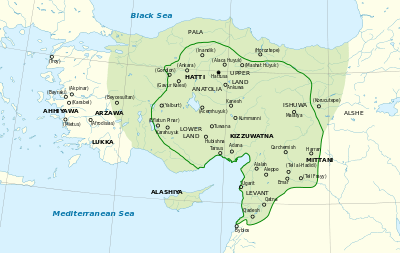List of ancient great powers
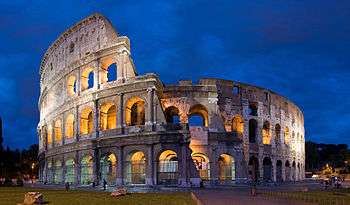
In a modern context, recognized great powers came about first in Europe during the post-Napoleonic era.[1] The formalization of the division between small powers[2] and great powers came about with the signing of the Treaty of Chaumont in 1814. A great power is a nation or state that, through its great economic, political and military strength, is able to exert power and influence over not only its own region of the world, but beyond to others.
The historical terms "Great Nation",[3][4][5] a distinguished aggregate of people inhabiting a particular country or territory, and "Great Empire",[6] a considerable group of states or countries under a single supreme authority, are colloquial; their use is seen in ordinary historical conversations (historical jargon).
- 3000 BC – 476 AD
Ancient Near East
| Ancient Near East | ||
|---|---|---|
|
[[File:14 century BC Eastern.png|thumb|center| Map of the ancient Near East during the Amarna Period, showing the great powers of the period.
]] |
The term ancient Near East encompasses the early civilizations during the time roughly spanning the Bronze Age from the rise of Sumer and Gerzeh in the 4th millennium BC to the expansion of the Persian Empire in the 6th century BC. The ancient Near East is generally understood as encompassing Mesopotamia (modern Iraq and Syria), Persia (modern Iran), Armenia, the Levant (modern Israel, Jordan, Lebanon, Syria, Palestinian Authority), and at times Anatolia (modern Turkey) and Ancient Egypt.
Sumer and Akkad
Sumer (or Šumer) was one of the early civilizations of the Ancient Near East, located in the southern part of Mesopotamia (modern-day Iraq) from the time of the earliest records in the mid 4th millennium BC until the rise of Babylonia in the late 3rd millennium BC. The term "Sumerian" applies to all speakers of the Sumerian language. Sumer (together with Ancient Egypt and the Indus Valley Civilization) is considered the first settled society in the world to have manifested all the features needed to qualify fully as a "civilization", eventually expanding into the first empire in history, the Akkadian Empire.
Mitanni
| Hurrians |
|---|
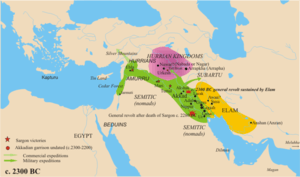
Hurrian kingdom in 2300 BC. ---- Akkad Elam |
The Hurrians refer to a people who inhabited northern Mesopotamia beginning approximately 2500 BC. The Hurrian kingdoms of the Ancient Near East was in Northern Mesopotamia and its people lived in the adjacent regions during the Bronze Age. The largest and most influential Hurrian nation was the kingdom of Mitanni. The population of the Hittite Empire in Anatolia to a large part consisted of Hurrians, and there is significant Hurrian influence in Hittite mythology.
By the Early Iron Age, the Hurrians had been assimilated with other peoples, except perhaps in the kingdom of Urartu. The Hurrian peoples were not incredibly united, existing as quasi-feudal kingdoms. The kingdom of Mitanni was at its height towards the close of the 14th century BC. By the 13th century BC, the Hurrian kingdoms had been conquered by foreign powers, chiefly the Assyrians.
Babylonia
The profound political, social, and cultural influence imposed upon the Near East by the civilization known as the Ancient Babylonian Empire was the most pervasive in this historical period. The city itself, Babylon, positioned itself as a center of pivotal historical developments for centuries. There were 3 major Babylonian Dynasties: Amorite, Kassite, and Chaldean. This political entity was most predominate within the southern portion of Mesopotamia. It existed as an unremitting rival of the northern Assyrian Mesopotamians. Although it was assaulted and militarily overcome on several occasions, it did exist as a stalwart presence from the later 3rd millennium BC to the middle of the 6th century BC. After the fall of the Assyrian Empire in 612 BC, the Babylonian Empire was the most powerful state in the ancient world. Its capital, Babylon, was beautifully adorned by King Nebuchadnezzar, who erected several famous buildings. Even after the Babylonian Empire had been overthrown by the Persian king Cyrus the Great in 539 BC, the city itself remained an important cultural center. This period would be considered the zenith of Babylon's dominance in its two-and-a-half millennium history. Ancient Babylon was officially conquered by the Achaemenid Persian Empire in the late 6th century BC.
Assyria
| Neo-Assyrian Empire |
|---|
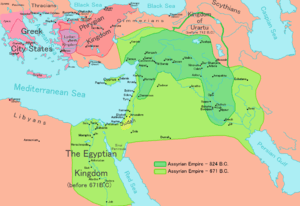
----
Neo-Assyrian Empire Assyrian Empire - 824 BC Assyrian Empire - 671 BC ---- Other Judah Phrygian Kingdom Lydian Kingdom Greek City States |
In the earliest historical times, the term Assyria referred to a region on the Upper Tigris river, named for its original capital, the ancient city of Assur. Later, as a nation and empire that came to control all of the Fertile Crescent, Egypt and much of Anatolia, the term "Assyria proper" referred to roughly the northern half of Mesopotamia (the southern half being Babylonia), with Nineveh as its capital. The Assyrian homeland was located near a mountainous region, extending along the Tigris as far as the high Gordiaean or Carduchian mountain range of Armenia, sometimes known as the "Mountains of Ashur". The Assyrian kings controlled a large kingdom at three different times in history. These are called the Old, Middle, and Neo-Assyrian kingdoms, or periods. The most powerful and best-known nation of these periods is the Neo-Assyrian Empire, 934–609 BC.
Shalmaneser III (858–823 BC) attacked and reduced Babylonia to vassalage, and defeated Aramea, Israel, Urartu, Phoenicia and the neo Hittite states, forcing all of these to pay tribute to Assyria. Shamshi-Adad V (822–811 BC) inherited an empire beset by civil war which he took most of his reign to quell. He was succeeded by Adad-nirari III who was merely a boy. The Empire was thus ruled by the famed queen Semiramis until 806 BC. In that year Adad-nirari III took the reins of power. After his premature death, Assyria failed to expand further during the reigns of Shalmaneser IV (782–773 BC), Ashur-dan III (772–755 BC) and Ashur-nirari V (754–746 BC).
Under Ashurbanipal (669–627 BC) its domination spanned from the Caucasus Mountains in the north to Nubia, Egypt and Arabia in the south, and from Cyprus and Antioch in the west to Persia in the east. Ashurbanipal destroyed Elam and smashed a rebellion led by his own brother Shamash-shum-ukim who was the Assyrian king of Babylon, exacting savage revenge on the Chaldeans, Nabateans, Arabs and Elamites who had supported him. Persia and Media were regarded as vassals of Ashurbanipal. He built vast libraries and initiated a surge in the building of temples and palaces.
Hittite Empire
| Hittite Empire |
|---|
The Hittites were an ancient people who spoke an Indo-European language, and established a kingdom centered at Hattusa in north-central Anatolia from the 18th century BC. In the 14th century BC, the Hittite empire was at its height, encompassing central Anatolia, north-western Syria as far as Ugarit, and upper Mesopotamia. After 1180 BC, the empire disintegrated into several independent "Neo-Hittite" city-states, some surviving until as late as the 8th century BC.

The Hittites were also famous for their skill in building and using chariots, as the Battle of Kadesh demonstrates. The Hittites were pioneers of the Iron Age, manufacturing iron artifacts from as early as the 14th century BC, making them possibly even the first to do so. The Hittites passed much knowledge and lore from the Ancient Near East to the newly arrived Greeks in Europe.
Hittite prosperity was mostly dependent on control of the trade routes and metal sources. Because of the importance of Northern Syria to the vital routes linking the Cilician gates with Mesopotamia, defense of this area was crucial, and was soon put to the test by Egyptian expansion under Pharaoh Rameses II. The outcome of the Battle of Kadesh is uncertain, though it seems that the timely arrival of Egyptian reinforcements prevented total Hittite victory. The Egyptians forced the Hittites to take refuge in the fortress of Kadesh, but their own losses prevented them from sustaining a siege. This battle took place in the 5th year of Rameses (c.1274 BC by the most commonly used chronology).
Phoenicia
| Ancient Phoenicia |
|---|
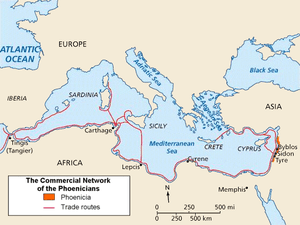
Phoenicia Territory in the 3rd century BC |
Phoenicia was a major power over the Mediterranean between 1200 BC and 539 BC.[7] This ancient Semitic thalassocratic civilization was situated on the western, coastal part of the Fertile Crescent and centered on the coastline of modern Lebanon. All major Phoenician cities were on the coastline of the Mediterranean, some colonies reaching the Western Mediterranean. It was an enterprising maritime trading culture that spread across the Mediterranean from 1550 BC to 300 BC. The Phoenicians used the galley, a man-powered sailing vessel, and are credited with the invention of the bireme.[8] They were famed in Classical Greece and Rome as 'traders in purple', referring to their monopoly on the precious purple dye of the Murex snail, used, among other things, for royal clothing, and for the spread of their alphabets, from which almost all modern phonetic alphabets are derived.
Ancient Persia (Iran)
Elam
| Elamite Empire |
|---|
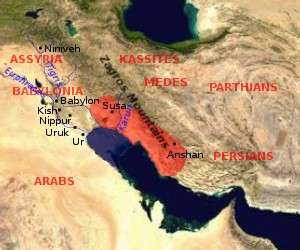
Elamite Empire
----
The approximate Bronze Age Elamite Empire extension of the Persian Gulf is shown.
|
Elam was situated just to the east of Mesopotamia and was one of the oldest recorded civilizations. Elam was centered in the far west and southwest of modern-day Iran, stretching from the lowlands of Khuzestan and Ilam Province (which takes its name from Elam), as well as a small part of southern Iraq. In the Old Elamite period (Middle Bronze Age), Elam consisted of kingdoms on the Iranian plateau, centered in Anshan, and from the mid-2nd millennium BC, it was centered in Susa in the Khuzestan lowlands.
Elam was part of the early cities of the Ancient Near East during the Chalcolithic (Copper Age). The emergence of written records from around 3000 BC also parallels Mesopotamian history where writing was used slightly earlier. Elamite strength was based on an ability to hold various areas together under a coordinated government that permitted the maximum interchange of the natural resources unique to each region. Traditionally, this was done through a federated governmental structure.
Elamite culture played a crucial role in the Gutian Empire (Persian Empire) especially during the Achaemenid dynasty that succeeded it, when the Elamite language remained among those in official use. The Elamite language is generally treated as an isolate language. As such, the Elamite period is considered a starting point for the history of Iran.
Median Empire
- 678–549 BC
| Median Empire |
|---|
 The Median empire at its greatest extent. |
The Median Empire was the first empire on the territory of Persia. By the 6th century BC, after having together with the Babylonians defeated the Neo-Assyrian Empire. In Greek references to "Median" people there is no clear distinction between the "Persians" and the "Medians"; in fact for a Greek to become "too closely associated with Iranian culture" was "to become medianized, not persianized". The Median kingdom was a short-lived Iranian state and the textual and archaeological sources of that period are rare and little could be known from the Median culture which nevertheless made a "profound, and lasting, contribution to the greater world of Iranian culture". The Medes were able to establish their own empire, the largest of its day, lasting for about sixty years, from the sack of Nineveh in 612 BC until 549 BC when Cyrus the Great established the Achaemenid Empire by defeating his overlord and grandfather, Astyages, king of Media.
Achaemenid Empire
- 550 BC–330 BC
| Achaemenid Empire |
|---|
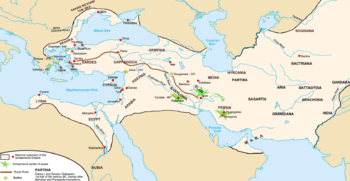
Achaemenid Persian Empire during its zenith
----
Outlying regions Achaemenid imperial region ---- cities, battles, power centers |
The Achaemenid Empire was the first of the Persian Empires to become a world empire. At the height of its power, the Empire spanned over three continents, namely Europe, Asia, and Africa, and was the most powerful empire of its time. It also eventually, either quickly in its earliest days or steadily over time, incorporated the following territories: in the east modern Afghanistan and beyond into central Asia, and parts of Pakistan; in the north and west all of Asia Minor (modern Turkey), parts of the Balkans peninsula (Thrace-Macedonia and Bulgaria-Paeonia), and most of the Black Sea coastal regions; in the west and southwest the territories of modern Iraq, northern Saudi-Arabia, Jordan, Israel, Lebanon, Syria, all significant population centers of ancient Egypt and as far west as portions of Libya.

Encompassing approximately 8.5 million square kilometers, the Achaemenid Empire was territorially the largest empire of antiquity. In its time it had political power over neighboring countries, and had high cultural and economic achievements during its lengthy rule over a vast region from its picturesque capital at Persepolis.
Alexander the Great (Alexander III of Macedon) defeated the Persian armies at Granicus (334 BC), followed by Issus (333 BC), and lastly at Gaugamela (331 BC). Afterwards, he marched on Susa and Persepolis which surrendered in early 330 BC. From Persepolis, Alexander headed north to Pasargadae where he visited the tomb of Cyrus, the burial of the man whom he had heard of from Cyropedia.
Parthian Empire
| Parthian Empire |
|---|
 The Parthian empire at its greatest extent. |
The Parthian Empire was the third Iranian Empire. At the height of its power, the empire ruled most of Greater Iran, Mesopotamia and Armenia. But unlike most other Iranian monarchies, the Parthian followed a vassalary system, which they adopted from the Seleucids. The Arsacid culture was not a single coherent state, but instead made up of numerous tributary (but otherwise independent) kingdoms.
The Parthians largely adopted the art, architecture, religious beliefs, and royal insignia of their culturally heterogeneous empire, which encompassed Persian, Hellenistic, and regional cultures. For about the first half of its existence, the Arsacid court adopted elements of Greek culture, though it eventually saw a gradual revival of Iranian traditions. The Arsacid rulers were titled the 'King of Kings', as a claim to be the heirs to the Achaemenid Empire; indeed, they accepted many local kings as vassals where the Achaemenids would have had centrally appointed, albeit largely autonomous, satraps. The court did appoint a small number of satraps, largely outside Iran, but these satrapies were smaller and less powerful than the Achaemenid potentates. With the expansion of Arsacid power, the seat of central government shifted from Nisa, Turkmenistan to Ctesiphon along the Tigris (south of modern Baghdad, Iraq), although several other sites also served as capitals. Although the Parthian Arsacids made way for a new Iranian dynasty, the Arsacid family continued to exist through the Arsacid dynasty of Armenia, the Arsacid dynasty of Iberia, and the Arsacid Dynasty of Caucasian Albania; all eponoymous branches of the Parthian Arsacids.
Sassanid Empire
| Sassanid Empire |
|---|
 The Sassanid Empire around its greatest extent |
The Sassanid Empire is the name used for the fourth Iranian dynasty, and the second Persian Empire (226 - 651). The empire's territory encompassed all of today's Iran, Iraq, Armenia, Afghanistan, eastern parts of Turkey, and parts of Syria, Pakistan, and large parts of Caucasia, Central Asia and Arabia. During Khosrau II's rule in 590–628 Egypt, Jordan, Palestine, Lebanon were also briefly annexed to the Empire, as well as far west as western Asia Minor. The Sassanid era, encompassing the length of the Late Antiquity period, is considered to be one of the most important and influential historical periods in Iran. In many ways the Sassanid period witnessed the highest achievement of Persian civilization. The empire is furthermore known for being the arch-rival of the neighboring Roman-Byzantine Empire for a period of over 400 years. As the Parthians were replaced by the Sassanids, they carried on the already century long lasting Roman-Persian Wars, which would eventually become the longest conflict in human history.
The empire constituted the last great Iranian Empire before the Muslim conquest and adoption of Islam. The climactic Byzantine–Sasanian War of 602–628 had drastically exhausted both the Byzantines as well as the Sassanids, laying the way open for an easy conquest. The Sassanids, heavily weakened, never mounted a truly effective resistance to the pressure applied by the initial Arab armies. Ctesiphon fell after a prolonged siege. Yazdegerd fled eastward from Ctesiphon, leaving behind him most of the Empire's vast treasury. The Arabs captured Ctesiphon shortly afterward, leaving the Sassanid government strapped for funds and acquiring a powerful financial resource for their own use. A number of Sassanid governors attempted to combine their forces to throw back the invaders, but the effort was crippled by the lack of a strong central authority, and the governors were defeated at the Battle of Nihawānd. The empire, with its military command structure non-existent, its non-noble troop levies decimated, its financial resources effectively destroyed, and the Asawaran knightly caste destroyed piecemeal, was utterly helpless in the face of the invaders. Upon hearing the defeat, Persian nobilities fled further inland to the eastern province of Khorasan.
Ancient Africa
The kingdoms of Africa were quite influential in and outside of their own realms. Ancient Egypt was a power to be contended with by both the Near East, the Mediterranean and Subsaharan Africa. Further to the south, the distant but never reclusive Kingdom of Kush gained a reputation for wealth and military vigor throughout the ancient world. The city states of Mossylon, Malao, Mundus and Opone in Somalia dominated the Red Sea-Indian Ocean trade.
Egypt
| Ancient Egypt |
|---|

The maximum territorial extent of Ancient Egypt (15th century BC)
----
Core Regions Territorial control |
Ancient Egypt was one of the world's first civilizations, with its beginnings in the fertile Nile valley around 3000 BC. Ancient Egypt reached the zenith of its power during the New Kingdom (1570–1070 BC) under great pharaohs. It expanded far south into Nubia and held wide territories in the Near East. The combination of a fertile river valley, natural borders that made an invasion unfeasible, and a military able to rise to the challenge when needed, turned Egypt into a major power. It was one of the first nations to have a system of writing and large scale construction projects. However, as neighboring civilizations developed militaries capable of crossing Egypt's natural barriers, the Egyptian armies were not always able to repel them and so by 1000 BC Egyptian influence as an independent civilization waned.[9]

The New Kingdom pharaohs established a period of unprecedented prosperity by securing their borders and strengthening diplomatic ties with their neighbors. Military campaigns waged under Tuthmosis I and his grandson Tuthmosis III extended the influence of the pharaohs to the largest empire Egypt had ever seen. Amenhotep IV ascended the throne and instituted a series of radical and chaotic reforms. Changing his name to Akhenaten, he touted the god Aten as the supreme deity, suppressed the worship of other deities, and attacked the power of the priestly establishment. Moving the capital to the new city of Akhetaten, he turned a deaf ear to foreign affairs and absorbed himself in his new religion and artistic style. After his death, the religion of the Aten was quickly abandoned, and the subsequent pharaohs erased all mention of Akhenaten's Egyptian heresy, now known as the Amarna Period.

Ramesses the Great ascended the throne, and went on to build more temples, erect more statues and obelisks, and sire more children than any other pharaoh in history. Ramesses led his army against the Hittites in the Battle of Kadesh and, after fighting to a stalemate, finally agreed to the first recorded peace treaty. Egypt's wealth, however, made it a tempting target for invasion, particularly by the Libyans and the Sea Peoples. Initially, the military was able to repel these invasions, but Egypt eventually lost control of Syria and Palestine. The impact of external threats was exacerbated by internal problems such as corruption, tomb robbery and civil unrest. The high priests at the temple of Amun in Thebes accumulated vast tracts of land and wealth, and their growing power splintered the country during the Third Intermediate Period.
The many achievements of the ancient Egyptians include the quarrying, surveying and construction techniques that facilitated the building of monumental pyramids, temples, and obelisks; a system of mathematics, a practical and effective system of medicine, irrigation systems and agricultural production techniques, the first known ships, Egyptian faience and glass technology, new forms of literature, and the earliest known peace treaty. Egypt left a lasting legacy. Its art and architecture were widely copied, and its antiquities carried off to far corners of the world. Its monumental ruins have inspired the imaginations of travellers and writers for centuries. A new-found respect for antiquities and excavations in the early modern period led to the scientific investigation of Egyptian civilization and a greater appreciation of its cultural legacy, for Egypt and the world.
Kerma
The Kerma culture was an early civilization which flourished from around 2500 BC to about 1600 BC in Nubia, present day Sudan, centered at Kerma. It seems to have been one of a number of Sudanese states during the Middle Kingdom period of Ancient Egypt. In its latest phase, lasting from about 1700–1500 BC, it absorbed the Sudanese kingdom of Sai and became a sizable, populous empire rivaling Egypt. Around 1500 BC, it was absorbed into the Egyptian Empire, but rebellions continued for centuries. By the 11th century BC, the more 'Egyptianized' Kingdom of Kush emerged, apparently from Kerma, and regained the region's independence from Egypt.[10]
Kush
| Kingdom of Kush |
|---|

The maximum territorial extent of Kush circa 700 BC. |
The Kingdom of Kush was the earliest of the Subsaharan states in Africa as well as the first to implement iron weapons. It was heavily influenced by Egyptian colonists, but in 1070 BC it became not only independent of Egypt but a fierce rival. It successfully fought off attempts by Egypt to reconquer it, and it began to extend influence over Upper Egypt. By the end of King Kashta's reign in 752 BC, Thebes was under Kushite control.
A slew of able successors took the rest of Egypt and reigned as the Twenty-fifth dynasty of Egypt stretching Kushite control from central Sudan to modern-day Israel. The Kushites did not maintain this empire for long and were beaten back by the Assyrians in 653 BC. However, Kush remained a powerful entity in the region. It continued to meddle in Egyptian affairs and control trade resources originating in Subsaharan Africa. It waged a hard-fought campaign against the Roman Empire (27 BC - 22 BC) under the leadership of Queen Amanirenas, and achieved a more than amicable peace with the young Augustus Caesar. The two states worked as allies, with Kush lending cavalry support to Rome in its conquest of Jerusalem in 70 AD.
The kingdom of Kush maintained its status as a regional power until its conquest by the Aksumite Empire in 350.
Macrobia

The Macrobians were an ancient people and kingdom situated in the Horn of Africa (Somalia) around the 1st millennium BC. According to Herodotus, the Macrobians practiced an elaborate form of embalming. This, in turn, suggested a knowledge on their part of anatomy and, at the very least, a grasp of the basics of chemistry. The Macrobians preserved the bodies of the dead by first extracting moisture from the corpses, then overlaying the bodies with a type of plaster, and finally decorating the exterior in vivid colors in order to imitate the deceased as realistically as possible. They then placed the body in a hollow crystal pillar, which they kept in their homes for a period of about a year.[11] Macrobia was also noted for its gold, which was so plentiful that the Macrobians shackled their prisoners in golden chains.[12]
The Ancient city-states located in northern Somalia, had a steady trade link with the Ancient Egyptians and exported precious natural resources such as myrrh, frankincense and gum. This trade network continued all the way into the classical era. The city states of Mossylon, Malao, Mundus and Tabae in Somalia engaged in a lucrative trade network connecting Somali merchants with Phoenicia, Ptolemaic Egypt, Greece, Parthian Persia, Saba, Nabataea and the Roman Empire. Somali sailors used the ancient Somali maritime vessel known as the 'beden' to transport their cargo.
Aksumite Empire
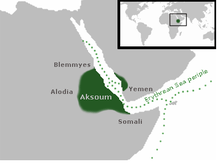
The Aksumite Empire was an important trading nation originating from Eritrea and Ethiopia in northeastern Africa, growing from the proto-Aksumite period ca. 4th century BC to achieve prominence by the 1st century AD. It was a major player in the commerce between the Roman Empire and Ancient India and the Aksumite rulers facilitated trade by minting their own currency. The state established its hegemony over the declining Kingdom of Kush and regularly entered the politics of the kingdoms on the Arabian peninsula, and would eventually extend its rule over the region with the conquest of the Himyarite Kingdom. It was considered by historians as one of the most powerful military powers in the world.
Carthaginian Empire
The Carthaginian Empire, also known as the Carthaginian Republic (alternatively "Carthaginian hegemony", or simply "Carthage") was the Phoenician city-state of Carthage and its sphere of influence, which included much of the coast of North Africa as well as substantial parts of coastal Iberia and the islands of the western Mediterranean from 814 to 146 BC.[13]
Ancient India
Ancient India, which consisted of the Indian subcontinent (the modern-day states of India, Pakistan, Nepal, and Bangladesh) was unified under many emperors and governments in history. Ancient texts mention India under the legendary emperor Bharata, these regions roughly form the entities of modern-day greater India. Several Indian empires were able to expand across southern Asia, incorporating much of the region, as well as sometimes beyond.
The history of India begins with evidence of human activity of Homo sapiens, as long as 75,000 years ago, or with earlier hominids including Homo erectus from about 500,000 years ago. The Indus Valley Civilisation, which spread and flourished in the northwestern part of the Indian subcontinent from c. 3300 to 1300 BC in present-day Pakistan and northwest India, was the first major civilisation in South Asia. A sophisticated and technologically advanced urban culture developed in the Mature Harappan period, from 2600 to 1900 BC. This Bronze Age civilisation collapsed before the end of the second millennium BC and was followed by the Iron Age Vedic Civilisation, which extended over much of the Indo-Gangetic plain and which witnessed the rise of major polities known as the Mahajanapadas. In one of these kingdoms, (Magadha), Mahavira and Gautama Buddha were born in the 6th or 5th century BC and propagated their Shramanic philosophies. Most of the subcontinent was conquered by the Maurya Empire during the 4th and 3rd centuries BC. Various parts of India ruled by numerous Middle kingdoms for the next 1,500 years, among which the Gupta Empire stands out. Southern India saw the rule of the Chalukyas, Cholas, Pallavas, Pandyas and Cheras. This period, witnessing a Hindu religious and intellectual resurgence, is known as the classical or "Golden Age of India". During this period, aspects of Indian civilisation, administration, culture, and religion (Hinduism and Buddhism) spread to much of Asia, while kingdoms in southern India had maritime business links with the Roman Empire from around 77 AD.
Indus
The Indus Valley Civilization was a Bronze Age civilization (3300–1300 BC). Along with Mesopotamia and Pharonic Egypt, was a cradle of early civilization in the Old World (Childe 1950). Of the three, the Indus was the most expansive covering an area of 1.25 million km2 [14] and encompassing what is today most of Pakistan parts of Afghanistan, Iran and north west India. It flourished in the basins of the Indus River, one of the major rivers of Asia, and the Ghaggar-Hakra River, which once coursed through northwest India and eastern Pakistan. At its peak, the Indus Civilization may have had a population of over five million Inhabitants of the ancient Indus river valley developed new techniques in handicraft (carnelian products, seal carving) and metallurgy (copper, bronze, lead, and tin). The Indus cities are noted for their urban planning, baked brick houses, elaborate drainage systems, water supply systems, and clusters of large non-residential buildings.[15] Indo-Aryans began to arrive here around 1700 BC and initially settle in the land of Sapta Sindhu[16]
Āryāvarta
| Āryāvarta |
|---|
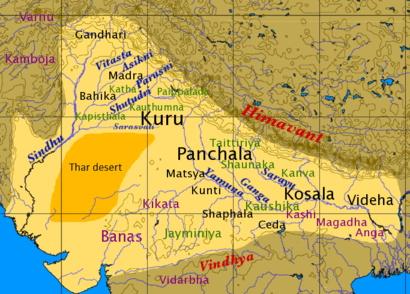
Land of the Vedic Aryan Civilization at its greatest extent circa 600 BC.
|
Āryāvarta (Sanskrit: आर्यावर्त, "abode of the Aryans") is a name for North India in classical Sanskrit literature.[17] The Manu Smriti (2.22) gives the name to "the tract between the Himalaya and the Vindhya ranges, from the Eastern (Bay of Bengal) to the Western Sea (Arabian Sea)". It was the homeland area of the Vedic civilization (ca.1750–500 BC) within which gave rise to the major Janapada states of the Rig Veda c. 1500 BC until 600 BC unified by a common shared culture which developed further into highly urbanised kingdoms and republics known as the sixteen great countries or Maha Janapadas. Most of these declined when one these states Magadha grew in power and expanded, its subsequent ruling dynasty's began forming the great empires of India that followed. It roughly corresponds to the Indo-Gangetic plain covering an area of approximately 700,000 sq km2.
Nanda Empire
The Nanda Empire originated from Magadha in Ancient India during the 5th and 4th centuries BC. At its greatest extent, the Nandas ruled much of Northern India.[18] The Nandas are sometimes described as the first empire builders in the recorded history of India. They inherited the large kingdom of Magadha. They built up a vast army.
The Nandas never had the opportunity to see their army up against Alexander the Great, who invaded India at the time of Dhana Nanda, since Alexander had to confine his campaign to the plains of Punjab, for his forces, at the prospect of facing a further mighty Magadha army, mutinied at the Hyphasis River (the modern Beas River) refusing to march any further. There had been confluence of Indian, Persian and Greek civilization in those period.
Continuing the early Hindu Vedas and Upnishads texts, Nanda had an influence on Indian social, legal and political systems. In addition, the region of Gandhara, or present-day eastern Afghanistan and northwest Pakistan, became a mixture of various cultures, including Greek and Indian ones, and gave rise to a hybrid culture, Greco-Buddhism, which influenced the artistic development of Mahayana Buddhism.
Maurya Empire
| Maurya Empire |
|---|

Maurya Empire at its greatest extent under Ashoka the Great.
|
The Mauryan Empire was the first political entity to unite most of the Indian subcontinent and expand into Central Asia and the Middle East. Its cultural influence also extended west into Egypt and Syria, and east into Thailand, China and Burma.
The Empire was founded in 322 BC by Chandragupta Maurya. Chandragupta waged a war against the nearby Greek powers and won, forcing the Greeks to surrender large amounts of land. Under the reign of Ashoka the Great, the empire became pacifist and turned to spreading its soft power in the form of Buddhism.[19] It has been estimated that the Maurya Dynasty controlled an unprecedented one-third of the world's entire economy, was home to one-third of the world's population at the time (an estimated 50 million out of 150 million human), contained the world's largest city of the time (Pataliputra, estimated to be larger than Rome under Emperor Trajan) at its height it covered an area of 5,000,000 km² (1,930,511 sq mi).
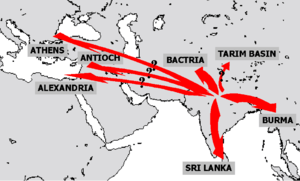
The Empire was divided into four provinces, which one of the four, look like a giant crescents. with the imperial capital at Pataliputra. From Ashokan edicts, the names of the four provincial capitals are Tosali (in the east), Ujjain in the west, Suvarnagiri (in the south), and Taxila (in the north). The head of the provincial administration was the Kumara (royal prince), who governed the provinces as king's representative. The kumara was assisted by Mahamatyas and council of ministers. This organizational structure was reflected at the imperial level with the Emperor and his Mantriparishad (Council of Ministers).
Historians theorize that the organization of the Empire was in line with the extensive bureaucracy described by Kautilya in the Arthashastra: a sophisticated civil service governed everything from municipal hygiene to international trade. According to Megasthenes, the empire wielded a military of 600,000 infantry, 30,000 cavalry, and 9,000 war elephants. A vast espionage system collected intelligence for both internal and external security purposes. Having renounced offensive warfare and expansionism, Ashoka nevertheless continued to maintain this large army, to protect the Empire and instill stability and peace across West and South Asia.
Shunga Empire
| Shunga Empire |
|---|
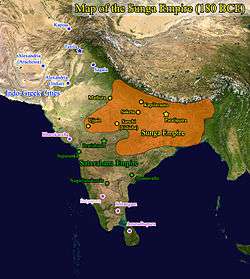
Shunga Empire
|
The Shunga Empire is a Magadha dynasty that controlled North-central and Eastern India as well as parts of the northwest (now Pakistan) from around 185 to 73 BC. It was established after the fall of the Indian Maurya Empire. The capital of the Shungas was Pataliputra. Later kings such as Bhagabhadra also held court at Vidisha, modern Besnagar in Eastern Malwa.[20] The Shunga Empire is noted for its numerous wars with both foreign and indigenous powers.
While there is much debate on the religious politics of the Shunga dynasty, it is recognized for a number of contributions. Art, education, philosophy, and other learning flowered during this period. Most notably, Patanjali's Yoga Sutras and Mahabhasya were composed in this period, Panini composed the first Sanskrit grammarian Ashtadayai. It is also noted for its subsequent mention in the Malavikaagnimitra. This work was composed by Kalidasa in the later Gupta period, and romanticized the love of Malavika and King Agnimitra, with a background of court intrigue. Artistry on the subcontinent also progressed with the rise of the Mathura school, which is considered the indigenous counterpart to the more Hellenistic Gandhara school of Afghanistan and Pakistan. During the historical Shunga period (185 to 73 BC), Buddhist activity also managed to survive somewhat in central India (Madhya Pradesh) as suggested by some architectural expansions that were done at the stupas of Sanchi and Barhut, originally started under Emperor Ashoka. It remains uncertain whether these works were due to the weakness of the control of the Shungas in these areas, or a sign of tolerance on their part.
The last of the Shunga emperor was Devabhuti (83–73 BC). He was assassinated by his minister (Vasudeva Kanva) and is said to have been overfond of the company of women. The Shunga dynasty was then replaced by the subsequent Kanvas.
Satavahana Empire
| Satavahanas |
|---|
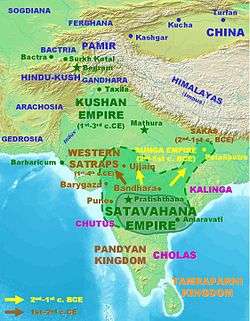
Satavahana Empire
|
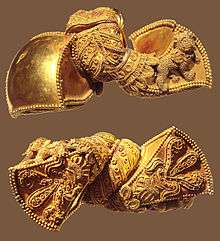
The Sâtavâhana Empire started out as feudatories to the Mauryan Empire but declared independence soon after the death of Ashoka (232 BC). They were the first Indic rulers to issue coins struck with their rulers embossed and are known for their patronage of Buddhism resulting in Buddhist monuments from Ellora to Amaravati.
After becoming independent around 230 BC, Simuka, the founder of the dynasty, conquered Maharashtra, Malwa and part of Madhya Pradesh. He was succeeded by his brother Kanha (or Krishna) (r. 207–189 BC), who further extended his kingdom to the west and the south. Sātakarnī I was the sixth ruler of the Satavahana. He is said to have ruled for 56 years. Satakarni defeated the Shunga dynasty of North India by wresting Western Malwa from them, and performed several Vedic sacrifices at huge cost, including the Horse Sacrifice – Ashwamedha yajna. He also was in conflict with the Kalinga ruler Kharavela, who mentions him in the Hathigumpha inscription. According to the Yuga Purana he conquered Kalinga following the death of Kharavela. He extended Satavahana rule over Madhya Pradesh and pushed back the Sakas from Pataliputra (he is thought to be the Yuga Purana's "Shata", an abbreviation of the full name "Shri Sata" that occurs on coins from Ujjain), where he subsequently ruled for 10 years. By this time the dynasty was well established, with its capital at Pratishthānapura (Paithan) in Maharashtra, and its power spreading into all of South India.
The Satavahanas formed a cultural bridge and played a vital role in trade and the transfer of ideas and culture to and from the Gangetic plains to the southern tip of India.
Chola Empire
| Chola Empire |
|---|
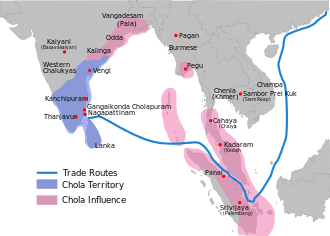 |
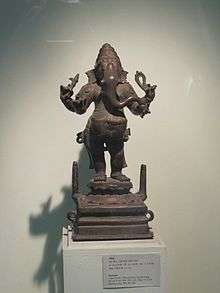
The Chola Empire ruled much of India and Southeast Asia. The Tamil dynasty which was one of the longest-ruling dynasties in southern India. The earliest datable references to this Tamil dynasty are in inscriptions from the 3rd century BC left by Ashoka, of Maurya Empire; as one of the Three Crowned Kings, the dynasty continued to govern over varying territory until the 13th century AD. By the 9th century, under Rajaraja Chola and his son Rajendra Chola, the Cholas rose as a notable power in south Asia. The Chola Empire stretched as far as Bengal. At its peak, the empire spanned almost 3,600,000 km2 (1,400,000 sq mi). Rajaraja Chola conquered all of peninsular South India and parts of the Sri Lanka. Rajendra Chola's navies went even further, occupying coasts from Burma (now Myanmar) to Vietnam,[21] the Andaman and Nicobar Islands, Lakshadweep, Sumatra, Java, Malaya in South East Asia and Pegu islands. He defeated Mahipala, the king of the Bengal, and to commemorate his victory he built a new capital and named it Gangaikonda Cholapuram.
The heartland of the Cholas was the fertile valley of the Kaveri River, but they ruled a significantly larger area at the height of their power from the later half of the 9th century till the beginning of the 13th century.[22] The whole country south of the Tungabhadra was united and held as one state for a period of two centuries and more.[23] Under Rajaraja Chola I and his son Rajendra Chola I, the dynasty became a military, economic and cultural power in South Asia and South-east Asia.[24][25] The power of the new empire was proclaimed to the eastern world by the celebrated expedition to the Ganges which Rajendra Chola I undertook and by the overthrow after an unprecedented naval war of the maritime empire of Srivijaya, as well as by the repeated embassies to China.[26]
During the period 1010–1200, the Chola territories stretched from the islands of the Maldives in the south to as far north as the banks of the Godavari River in Andhra Pradesh.[27] Rajaraja Chola conquered peninsular South India, annexed parts of what is now Sri Lanka and occupied the islands of the Maldives.[25] Rajendra Chola sent a victorious expedition to North India that touched the river Ganges and defeated the Pala ruler of Pataliputra, Mahipala. He also successfully invaded kingdoms of the Malay Archipelago.[28][29] The Chola dynasty went into decline at the beginning of the 13th century with the rise of the Pandyas, who ultimately caused their downfall.[30][31][32]
The Cholas left a lasting legacy. Their patronage of Tamil literature and their zeal in building temples has resulted in some great works of Tamil literature and architecture.[25] The Chola kings were avid builders and envisioned the temples in their kingdoms not only as places of worship but also as centres of economic activity.[33][34] They pioneered a centralised form of government and established a disciplined bureaucracy.
Gupta Empire
| Gupta Empire |
|---|
|
|
In the 4th and 5th centuries, the Gupta Empire unified much of India. This period is called the Golden Age of India and was marked by extensive achievements in science, technology, engineering, art, dialectic, literature, logic, mathematics, astronomy, religion and philosophy that crystallized the elements of what is generally known as Hindu culture. Chandragupta I, Samudragupta, and Chandragupta II were the most notable rulers of the Gupta dynasty.
The high points of this cultural creativity are magnificent architectures, sculptures and paintings. The Gupta period produced scholars such as Kalidasa, Aryabhata, Varahamihira, Vishnu Sharma, and Vatsyayana who made great advancements in many academic fields. Science and political administration reached new heights during the Gupta era. Strong trade ties also made the region an important cultural center and set the region up as a base that would influence nearby kingdoms and regions in Burma, Sri Lanka, Malay Archipelago and Indochina.
Ancient China
Shang Kingdom
The Shang dynasty (Chinese: 商朝; pinyin: Shāng cháo) or Yin dynasty (Chinese: 殷代; pinyin: Yīn dài), according to traditional historiography, ruled in the Yellow River valley in the second millennium BC, succeeding the Xia dynasty and followed by the Zhou dynasty. The classic account of the Shang comes from texts such as the Classic of History, Bamboo Annals and Records of the Grand Historian. According to the traditional chronology based upon calculations made approximately 2,000 years ago by Liu Xin, the Shang ruled from 1766 BC to 1122 BC, but according to the chronology based upon the "current text" of Bamboo Annals, they ruled from 1556 BC to 1046 BC. The Xia–Shang–Zhou Chronology Project dated them from c. 1600 BC to 1046 BC. At its peak 1122 BC it covered an area of 1,250,000 km2.[35]
Zhou Kingdom
The Zhou dynasty (c. 1046–256 BC; Chinese: 周朝; pinyin: Zhōu Cháo; Wade–Giles: Chou1 Ch'ao2 [tʂóʊ tʂʰɑ̌ʊ]) was a Chinese dynasty that followed the Shang dynasty and preceded the Qin dynasty. Although the Zhou dynasty lasted longer than any other dynasty in Chinese history, the actual political and military control of China by the dynasty, surnamed Ji (Chinese: 姬), lasted only until 771 BC, a period known as the Western Zhou.
This period of Chinese history produced what many consider the zenith of Chinese bronze-ware making. The dynasty also spans the period in which the written script evolved into its modern form with the use of an archaic clerical script that emerged during the late Warring States period.
Qin Empire
| Qin Dynasty |
|---|
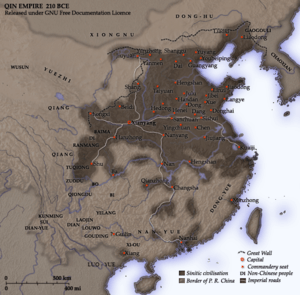
Qin Empire in 210 BC
----
Qin region Outlying regions |
The Qin Dynasty was preceded by the feudal Zhou Dynasty and followed by the Han Dynasty in China. The unification of China in 221 BC under the First Emperor Qin Shi Huang marked the beginning of Imperial China, a period which lasted until the fall of the Qing Dynasty in 1912.
In 214 BC Qin Shihuang secured his boundaries to the north with a fraction (100,000 men) of his large army, and sent the majority (500,000 men) south to seize still more land. Prior to the events leading to Qin dominance over China, they had gained possession of much of Sichuan to the southwest. The Qin army was unfamiliar with the jungle terrain, and it was defeated by the southern tribes' guerrilla warfare tactics with over 100,000 men lost. However, in the defeat Qin was successful in building a canal to the south, which they used heavily for supplying and reinforcing their troops during their second attack to the south. Building on these gains, the Qin armies conquered the coastal lands surrounding Guangzhou, and took the provinces of Fuzhou and Guilin. They struck as far south as Hanoi. After these victories in the south, Qin Shihuang moved over 100,000 prisoners and exiles to colonize the newly conquered area. In terms of extending the boundaries of his empire, the First Emperor was extremely successful in the south.
Despite its military strength, the Qin Dynasty did not last long. When the first emperor died in 210 BC, his son was placed on the throne by two of the previous emperor's advisers, in an attempt to influence and control the administration of the entire country through him. The advisors squabbled among themselves, however, which resulted in both their deaths and that of the second Qin emperor. Popular revolt broke out a few years later, and the weakened empire soon fell to a Chu lieutenant, who went on to found the Han Dynasty. Despite its rapid end, the Qin Dynasty influenced future Chinese regimes, particularly the Han, and the European name for China is derived from it.
Han Empire
| Han Dynasty |
|---|
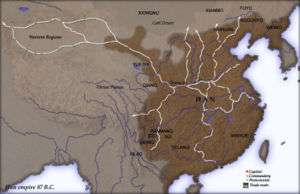
Han Empire in 87 BC
----
Han region Outlying regions |
The Han Dynasty (206 BC – AD 220), lasting 400 years, is commonly considered within China to be one of the greatest periods in the entire history of China. At its height, the Han empire extended over a vast territory of 6 million km2 and housed a population of approximately 55 million. During this time period, China became a military, economic, and cultural powerhouse. The empire extended its political and cultural influence over Korea, Japan, Mongolia, Vietnam, and Central Asia before it finally collapsed under a combination of domestic and external pressures.
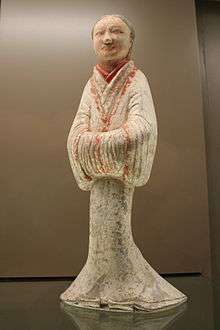
The Han Empire was divided into areas directly controlled by the central government, known as commanderies, and a number of semi-autonomous kingdoms. These kingdoms gradually lost all vestiges of their independence, particularly following the Rebellion of the Seven States. The Xiongnu, a nomadic confederation which dominated the eastern Eurasian Steppe, defeated the Han army in battle in 200 BC. Following the defeat, a political marriage alliance was negotiated in which the Han became the de facto inferior partner. When, despite the treaty, the Xiongnu continued to raid Han borders, Emperor Wu of Han (r. 141–87 BC) launched several military campaigns against them. The ultimate Han victory in these wars eventually forced the Xiongnu to accept vassal status as Han tributaries. These campaigns expanded Han sovereignty into the Tarim Basin of Central Asia and helped establish the vast trade network known as the Silk Road, which reached as far as the Mediterranean world. Han forces managed to divide the Xiongnu into two competing nations, the Southern and Northern Xiongnu, and forced the Northern Xiongnu across the Ili River. Despite these victories, the territories north of Han's borders were quickly overrun by the nomadic Xianbei confederation. The Han Dynasty was arguably one of the strongest's empires in the world during the reign of Emperor Wu, though was established as the largest.
Jin Empire
The Jin dynasty (simplified Chinese: 晋朝; traditional Chinese: 晉朝; pinyin: Jìn Cháo; Wade–Giles: Chin⁴-ch'ao², IPA: [tɕîn tʂʰɑ̌ʊ];), was a dynasty in Chinese history, lasting between the years 265 and 420 AD. There are two main divisions in the history of the dynasty, the first being Western Jin (西晉, 265–316) and the second Eastern Jin (東晉, 317–420). Western Jin was founded by Sima Yan, with its capital at Luoyang, while Eastern Jin was begun by Sima Rui, with its capital at Jiankang. The two periods are also known as Liang Jin (兩晉; literally: two Jin) and Sima Jin (司馬晉) by scholars, to distinguish this dynasty from other dynasties that use the same Chinese character, such as the Later Jin dynasty (後晉).
Ancient Europe
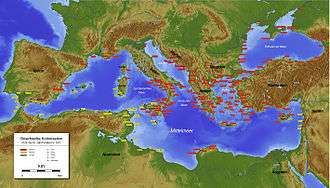
Ancient Greece is the civilization belonging to the period of Greek history lasting from the Archaic period of the 8th to 6th centuries BC to 146 BC and the Roman conquest of Greece after the Battle of Corinth. At the center of this time period is Classical Greece, which flourished during the 5th to 4th centuries BC, at first under Athenian leadership successfully repelling the military threat of Persian invasion. The Athenian Golden Age ends with the defeat of Athens at the hands of Sparta in the Peloponnesian War in 404 BC. Following the conquests of Alexander the Great, Hellenistic civilization flourished from Central Asia to the western end of the Mediterranean Sea. Classical Greek culture had a powerful influence on the Roman Empire, which carried a version of it to many parts of the Mediterranean region and Europe, for which reason Classical Greece is generally considered to be the seminal culture which provided the foundation of Western civilization.
Athens, after a tyranny in the second half of the 6th century, founded the Europe's first democracy as a radical solution to prevent the aristocracy regaining power. A citizens' assembly (the Ecclesia), for the discussion of city policy, had existed since the reforms of Draco; all citizens were permitted to attend after the reforms of Solon, but the poorest citizens could not address the assembly or run for office. With the establishment of the democracy, the assembly became the de jure mechanism of government; all citizens had equal privileges in the assembly. However, non-citizens, such as foreigners living in Athens or slaves, had no political rights at all. After the rise of the democracy in Athens, other city-states founded democracies. However, many retained more traditional forms of government. As so often in other matters, Sparta was a notable exception to the rest of Greece, ruled through the whole period by not one, but two hereditary monarchs. This was a form of diarchy.
Athens
| Ancient Athens |
|---|
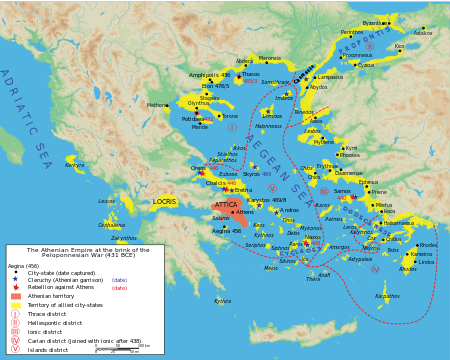
Map of Ancient Athens in 431 BC. |
Ancient Athens was inhabited around 3,000 years ago. Athens has one of the longest histories of any city in Europe and in the world. It became the leading city of Ancient Greece in the first millennium BC. Its cultural achievements during the 5th century BC laid the foundations of western civilization. During the Middle Ages, Athens experienced decline and then a recovery under the Byzantine Empire. Athens was relatively prosperous during the Crusades, benefiting from Italian trade.

Fifth-century Athens refers to the Greek city-state Athens in period of roughly 480 BC-404 BC. This was a period of Athenian political hegemony, economic growth and cultural flourishing known as the Golden Age of Athens or Age of Pericles. The period began in 480 BC when an Athenian-led coalition of city-states, known as the Delian League, defeated the Persians at Salamis. As the fifth century wore on, what started as an alliance of independent city-states gradually became an Athenian empire. Eventually, Athens abandoned the pretense of parity among its allies and relocated the Delian League treasury from Delos to Athens, where it funded the building of the Athenian Acropolis. With its enemies under its feet and its political fortunes guided by legendary statesman and orator Pericles, Athens as a center of literature, philosophy (see Greek philosophy) and the arts (see Greek theatre). Some of the most important figures of Western cultural and intellectual history lived in Athens during this period: the dramatists Aeschylus, Aristophanes, Euripides and Sophocles, the philosophers Aristotle, Plato and Socrates.
Sparta
| Lacedaemon |
|---|
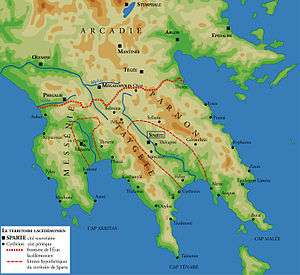
Territory of ancient Sparta |
Sparta was a Dorian Greek military state, originally centered in Laconia. As a city-state devoted to military training, Sparta possessed the most formidable army in the Greek world, and after achieving notable victories over the Athenian and Persian Empires, regarded itself as the natural protector of Greece.[36] Laconia or Lacedaemon (Λακεδαίμων) was the name of the wider city-state centered at the city of Sparta, though the name "Sparta" is now used for both.
Following the victories in the Messenian Wars (631 BC), Sparta's reputation as a land-fighting force was unequaled.[37] In 480 BC a small Spartan unit under King Leonidas made a legendary last stand against a massive, invading Persian army at the Battle of Thermopylae. One year later, Sparta assembled at full strength and led a Greek alliance against the Persians at Plataea. There, a decisive Greek victory put an end to the Greco-Persian War along with Persian ambition of expanding into Europe. Even though this war was won by a pan-Hellenic army, credit was given to Sparta, who besides being the protagonist at Thermopylae and Plataea, had been the nominal leader of the entire Greek expedition.[38]
In later Classical times, Sparta along with Athens, Thebes and Persia had been the main regional powers fighting for supremacy against each other. As a result of the Peloponnesian War, Sparta, a traditionally continental culture, became a naval power. At the peak of her power she subdued many of the key Greek states and even managed to overpower the powerful Athenian navy. By the end of the 5th century she stood out as a state which had defeated at war both the Persian and Athenian Empires, a period which marks the Spartan Hegemony.
Sparta was, above all, a militarist state, and emphasis on military fitness began virtually at birth.
Macedonia
| Macedon |
|---|

Map of Alexander the Great's empire. |
Macedon was the name of an ancient kingdom in the northernmost part of ancient Greece, bordering the kingdom of Epirus on the west and the region of Thrace to the east. For a brief period it became the most powerful state in the world after Alexander the Great conquered most of the known world, including the entire Achaemenid Empire, inaugurating the Hellenistic period of Greek history.
The rise of Macedon, from a small kingdom at the periphery of Classical Greek affairs, to one which came to dominate the entire Hellenic world (and beyond), occurred in the space of just 25 years, between 359–336 BC. This ascendancy is largely attributable to the personality and policies of Philip II of Macedon. Philip's military skills and expansionist vision of Macedonian greatness brought him early success. He had however first to re-establish a situation which had been greatly worsened by the defeat against the Illyrians in which King Perdiccas himself had died. The Paionians and the Thracians had sacked and invaded the eastern regions of the country, while the Athenians had landed, at Methoni on the coast, a contingent under a Macedonian pretender called Argeus. Using diplomacy, Philip pushed back Paionians and Thracians promising tributes, and crushed the 3,000 Athenian hoplites (359). Momentarily free from his opponents, he concentrated on strengthening his internal position and, above all, his army. His most important innovation was doubtless the introduction of the phalanx infantry corps, armed with the famous sarissa, an exceedingly long spear, at the time the most important army corps in Macedonia.
Philip's son, Alexander the Great, managed to briefly extend Macedonian power not only over the central Greek city-states, but also to the Persian empire, including Egypt and lands as far east as the fringes of India. Alexander's adoption of the styles of government of the conquered territories was accompanied by the spread of Greek culture and learning through his vast empire. Although the empire fractured into multiple Hellenic regimes shortly after his death, his conquests left a lasting legacy, not least in the new Greek-speaking cities founded across Persia's western territories, heralding the Hellenistic period. In the partition of Alexander's empire among the Diadochi, Macedonia fell to the Antipatrid dynasty, which was overthrown by the Antigonid dynasty after only a few years.
Hellenistic States
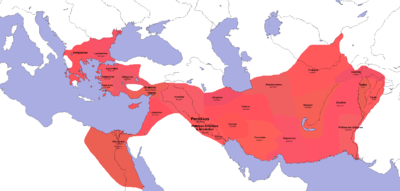
Alexander had made no special preparations for his succession in his newly founded empire and the Apocrypha of his death state that on his death-bed he willed it to those that performed actions well and powerfully. The result was the wars of the Diadochi between his generals (the Diadochi, or 'Successors'), which lasted for forty years before a more-or-less stable arrangement was established, consisting of four major domains:
- The Antigonid dynasty in Macedon and central Greece;
- The Ptolemaic dynasty in Egypt based at Alexandria;
- The Seleucid dynasty in Syria and Mesopotamia based at Antioch;
- The Attalid dynasty in Anatolia based at Pergamum.
A further two kingdoms later emerged, the so-called Greco-Bactrian and Indo-Greek kingdom. Hellenistic culture thrived in its preservation of the past. The states of the Hellenistic period were deeply fixated with the past and its seemingly lost glories. Athens retained its position as the most prestigious seat of higher education, especially in the domains of philosophy and rhetoric, with considerable libraries. Alexandria was a center of Greek learning and the Library of Alexandria had 700,000 volumes. The city of Pergamon became a major center of book production, possessing a library of some 200,000 volumes, second only to Alexandria's. The island of Rhodes boasted a famous finishing school for politics and diplomacy. Antioch was founded as a metropolis and center of Greek learning which retained its status into the era of Christianity. Seleucia replaced Babylon as the metropolis of the lower Tigris.
Seleucid Empire
| Seleucid Empire |
|---|
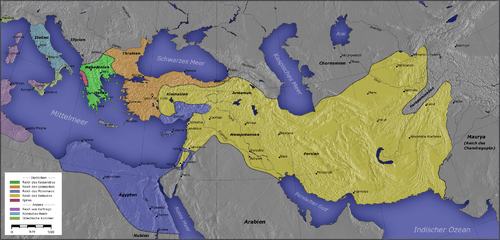
Seleucid Empire amongst other Hellenistic kingdoms.
|
The Seleucid Empire was a Hellenistic empire, and the eastern remnant of the former Achaemenid Persian Empire following its breakup after Alexander the Great's invasion. The Seleucid Empire was centered in the near East. It was a center of Hellenistic culture which maintained the Greek customs and Greek-speaking Macedonian elite.
Seleucid expansion into Greece was abruptly halted after decisive defeats at the hands of the Roman army. Much of the eastern part of the empire was conquered by the Parthians under Mithridates I of Parthia in the mid-2nd century BC, yet the Seleucid kings continued to rule a rump state from Syria until the invasion by Armenian king Tigranes the Great and their ultimate overthrow by the Roman general Pompey.
Ptolemaic Empire
| Ptolemaic empire |
|---|

Ptolemaic Empire in 300 BC.
|
The Ptolemaic dynasty, sometimes also known as the Lagids, was a Greek[39][40][41][42] royal family which ruled the Ptolemaic Empire in Egypt during the Hellenistic period.
Ptolemy, one of the seven somatophylakes (bodyguards) who served as Alexander the Great's generals and deputies, was appointed satrap of Egypt after Alexander's death in 323 BC. In 305 BC, he declared himself King Ptolemy I, later known as "Soter" (saviour). The Egyptians soon accepted the Ptolemies as the successors to the pharaohs of independent Egypt. Ptolemy's family ruled Egypt until the Roman conquest of 30 BC. All the male rulers of the dynasty took the name Ptolemy.
Ptolemaic Egypt began when Ptolemy I Soter declared himself Pharaoh of Egypt in 305 BC and ended with the death of queen Cleopatra VII of Egypt and the Roman conquest in 30 BC. The Ptolemaic Kingdom was a powerful Hellenistic state, extending from southern Syria in the east, to Cyrene to the west, and south to the frontier with Nubia. Alexandria became the capital city and a center of Greek culture and trade. To gain recognition by the native Egyptian populace, they named themselves as the successors to the Pharaohs. The later Ptolemies took on Egyptian traditions, had themselves portrayed on public monuments in Egyptian style and dress, and participated in Egyptian religious life. Hellenistic culture continued to thrive in Egypt well after the Muslim conquest. The Ptolemies faced rebellions of native Egyptians often caused by an unwanted regime and were involved in foreign and civil wars that led to the decline of the kingdom and its annexation by Rome.
Roman Empire
| Roman Empire |
|---|
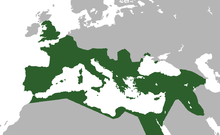 The Roman Empire under Trajan in 117 AD, at the peak of its territorial power. |
The Roman Empire is widely known as ancient Europe's largest and most powerful civilization. After the Punic Wars Rome was already one of the biggest empires on the planet but its expansion continued with the invasions of Greece and Asia Minor. By 27 BC Rome had control over half of Europe as well as Northern Africa and large amounts of the Middle East. Rome also had a developed culture, building on the earlier Greek culture. From the time of Augustus to the Fall of the Western Empire, Rome dominated Western Eurasia, comprising the majority of its population.
Roman expansion began long before the state was changed into an Empire and reached its zenith under emperor Trajan with the conquest of Mesopotamia and Armenia in AD 113. The period of the "Five Good Emperors" saw a successions of peaceful years and the Empire was prosperous. Each emperor of this period was adopted by his predecessor. The Nerva–Antonine dynasty was a dynasty of seven consecutive Roman Emperors who ruled over the Roman Empire from 96 to 192. These Emperors are Nerva, Trajan, Hadrian, Antoninus Pius, Marcus Aurelius, Lucius Verus, and Commodus.
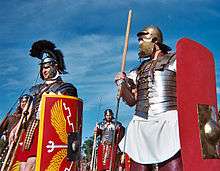
The last two of the "Five Good Emperors" and Commodus are also called Antonines. After his accession, Nerva, who succeeded Domitian, set a new tone: he restored much confiscated property and involved the Roman Senate in his rule. Starting in 101, Trajan undertook two military campaigns against the gold rich Dacia, which he finally conquered in 106 (see Trajan's Dacian Wars). In 112, Trajan marched on Armenia and annexed it to the Roman Empire. Then he turned south into Parthia, taking several cities before declaring Mesopotamia a new province of the empire, and lamenting that he was too old to follow in the steps of Alexander the Great. During his rule, the Roman Empire expanded to its largest extent, and would never again advance so far to the east. Hadrian's reign was marked by a general lack of major military conflicts, but he had to defend the vast territories that Trajan had acquired.
At this territorial peak, the Roman Empire controlled approximately 5,900,000 km² (2,300,000 sq.mi.) of land surface. Ancient Rome's influence upon the culture, law, technology, arts, language, religion, government, military, and architecture of Western civilization continues to this day.
Ancient Eurasian Steppe
Scythia
Ancient Greeks gave the name Scythia (or Great Scythia) to all the lands north-east of Europe and the northern coast of the Black Sea. According to Oxford University author's Samuel Arrowsmith, B Fellowes and Luke Graves Hansard in their 1832 book A Grammar of Ancient Geography, Scythia had two parts, Scythia Intra Imaum and Scythia Extra Imaum[43] both covering a combined area of 1,129,000 mi² or 2,924,096 km².[44]
The Scythians – the Greeks' name for this nomadic people – inhabited Scythia from at least the 11th century BC to the 2nd century AD.[45] Its location and extent varied over time but usually extended farther to the west than is indicated on the map opposite.[46]
Sarmatia
The Sarmatians (Latin: Sarmatæ or Sauromatæ, Greek: Σαρμάται, Σαυρομάται) were an Iranian people during classical antiquity, flourishing from about the 5th century BC to the 4th century AD.[47][48] They spoke Scythian, an Indo-European language from the Eastern Iranian family.
Originating in Central Asia, the Sarmatians started their westward migration around the 6th century bc, coming to dominate the closely related Scythians by the 2nd century bc.[49] The Sarmatians differed from the Scythians in their veneration of the god of fire rather than god of nature, and their women's prominent role in warfare, which possibly served as the inspiration for the Amazons.[49] At their greatest reported extent, around 1st century AD, these tribes ranged from the Vistula River to the mouth of the Danube and eastward to the Volga, bordering the shores of the Black and Caspian seas as well as the Caucasus to the south.[50] Their territory, which was known as Sarmatia to Greco-Roman ethnographers, corresponded to the western part of greater Scythia (mostly modern Ukraine and Southern Russia, also to a smaller extent north eastern Balkans around Moldova). According to authors Arrowsmith, Fellowes and Graves Hansard in their book A Grammar of Ancient Geography published in 1832, Sarmatia had two parts, Sarmatia Europea[51] and Sarmatia Asiatica[52] covering a combined area of 503,000 sq mi or 1,302,764 km2.
Xiongnu
| Xiongnu |
|---|

Xiongnu c.174
----
Xiongnu Region Outlying regions |
Xiongnu (Hsiung nu) was a nomadic empire that flourished in the central Asia. Their origin is debatable, but they probably spoke either an Iranian language, Proto Turkic, or a Proto Mongolic or a Yeniseian language. They conquered most of modern Mongolia under their leader Toumen (220–209 BC) in the 3rd century BC. During Modu's reign (209–174 BC) they defeated both the Donghu in the east and Yuezhi in the west and they began threatening Han China.
The Great Wall of China had been constructed to protect Chinese towns from the Xiongnu attacks. While the Chinese were trying to bring the Xiongnu under control, something of high significance happened: cross-cultural encounters. A large variety of people (such as traders, ambassadors, hostages, parents in cross-cultural marriages, etc.) served as helpers that passed on ideas, values, and techniques across cultural boundary lines. These encounters helped cultures learn from other cultures. Xiongnu empire disintegrated into two parts during the 1st century, eventually the Xiongnu fell due to the defeat in the Han–Xiongnu War.
Hunnic Empire
- 370–454
| Hunnic Empire |
|---|

The Hunnic Empire
----
Attila's imperial capital (approximate) Attila's empire (approximate) Non-Hunnic Regions |
Huns were nomadic people who were known for their hordes of mounted archers. Their language seems to be Turkic; but Mongolic, Yeniseian, Uralic etc., are also postulated. After 370 under a certain Balamber they founded an empire in the East Europe defeating Alans and Goths. They triggered the great migration which eventually caused the collapse of the West Roman Empire.[53]
The death of Rugila in 434 left the sons of his brother Mundzuk, Attila and Bleda, in control of the united Hun tribes. Attila the Hun ruled of the Huns from 434 until his death in 453. Under his rule and leader of the Hunnic Empire, the empire stretched from Germany to the Ural River and from the Danube River to the Baltic Sea. Hunnic khagan Atilla invaded Europe. The rise of the Huns around 370 overwhelmed the Gothic kingdoms. Many of the Goths migrated into Roman territory in the Balkans, while others remained north of the Danube under Hunnic rule.
During Attila the Hun's rule, he was one of the most fearsome enemies of the Western and Eastern Roman Empire. He invaded the Balkans twice and marched through Gaul (modern France) as far as Orléans before being defeated at the Battle of Châlons. Although his invasion of Gaul was checked at Chalons, he appeared in North Italy in the next year. After Atilla’s death in 453, the Hunnic Empire collapsed.
See also
- General topics
- History of warfare
- Political science
- Power in international relations, Expansionism (List of examples of expansionism)
- General Lists
- List of largest empires, List of countries spanning more than one continent, List of historical countries and empires spanning more than one continent
- Citations
- ↑ Webster, Charles K, Sir (ed), British Diplomacy 1813–1815: Selected Documents Dealing with the Reconciliation of Europe, G Bell (1931), p307.
- ↑ Toje, A. (2010). The European Union as a small power: After the post-Cold War. New York: Palgrave Macmillan.
- ↑ Edward Sylvester Ellis, Charles F. Horne (1906). The story of the greatest nations: from the dawn of history to the twentieth century : a comprehensive history founded upon the leading authorities, including a complete chronology of the world and a pronouncing vocabulary of each nation, Volume 1. F. R. Niglutsch.
- ↑ In Powell, T. (1888). Illustrated home book of the world's great nations: Being a geographical, historical and pictorial encyclopedia. Chicago: People's Pub. Co.
- ↑ Yonge, C. M. (1882). A pictorial history of the world's great nations: From the earliest dates to the present time. New York: S. Hess.
- ↑ Harrison, T., & J. Paul Getty Museum. (2009). The great empires of the ancient world. Los Angeles, Calif: J. Paul Getty Museum.
- ↑ "Timeline of Carthaginian History". Retrieved 5 October 2014.
- ↑ Casson, Lionel (December 1, 1995). Ships and Seamanship in the Ancient World. The Johns Hopkins University Press. pp. 57–58. ISBN 978-0-8018-5130-8.
- ↑ "Math in Ancient Egypt". Retrieved 5 October 2014.
- ↑ Kerma culture
- ↑ Society of Arts (Great Britain), Journal of the Society of Arts, Volume 26, (The Society: 1878), pp.912–913.
- ↑ John Kitto, James Taylor, The popular cyclopædia of Biblical literature: condensed from the larger work, (Gould and Lincoln: 1856), p.302.
- ↑ Glenn Markoe (2000). Phoenicians. University of California Press. p. 55. ISBN 978-0-520-22614-2. Retrieved 11 February 2013.
- ↑ Blanc De La, Paul. "Indus Epigraphic Perspectives: Exploring Past Decipherment Attempts & Possible New Approaches 2013 Pg 11" (PDF). University of Ottawa Research. University of Ottawa. Retrieved 11 August 2014.
- ↑ Wright 2010, pp. 115–125.
- ↑ Nath Sen, Sailendra. Ancient Indian History and Civilization. Google Books September 1999. New Age International Publishers. Retrieved 11 August 2014.
- ↑ Manu Smriti 2.22
- ↑ Radha Kumud Mookerji, Chandragupta Maurya and His Times, 4th ed. (Delhi: Motilal Banarsidass, 1988 [1966]), 31, 28–33.
- ↑ "Ancient India - Chandragupta Maurya". Retrieved 5 October 2014.
- ↑ Wilber, D. N.; Ettinghausen, R. (1975). "From Byzantium to Sasanian Iran and the Islamic World. Three Modes of Artistic Influence". Artibus Asiae. 37 (1): 162. doi:10.2307/3250228.
- ↑ "The Last Years of Cholas: The decline and fall of a dynasty". Retrieved 5 October 2014.
- ↑ K.A. Nilakanta Sastri, A History of South India, p 5
- ↑ K.A. Nilakanta Sastri, A History of South India, p 157
- ↑ Kulke and Rothermund, p 115
- 1 2 3 Keay, p 215
- ↑ K.A. Nilakanta Sastri, A History of South India, p 158
- ↑ Majumdar, p 407
- ↑ The kadaram campaign is first mentioned in Rajendra's inscriptions dating from his 14th year. The name of the Srivijaya king was Sangrama Vijayatungavarman. K.A. Nilakanta Sastri, The CōĻas, pp 211–220
- ↑ Meyer, p 73
- ↑ K.A. Nilakanta Sastri, A History of South India, p 192
- ↑ K.A. Nilakanta Sastri, A History of South India, p 195
- ↑ K.A. Nilakanta Sastri, A History of South India, p 196
- ↑ Vasudevan, pp 20–22
- ↑ Keay, pp 217–218
- ↑ Turchin, Peter; Adams, Jonathan M; Hall, Thomas D (December 2006). "East-West Orientation of Historical Empires" (PDF). Journal of world-systems research. 12 (2): 219–29. ISSN 1076-156X. Retrieved 12 August 2010.
- ↑ The Macedonian Empire: the era of warfare under Philip II and Alexander the Great, 359–323 BC. - James R.
- ↑ "A Historical Commentary on Thucydides" - David Cartwright, p. 176
- ↑ Britannica ed. 2006, "Sparta"
- ↑ Cleopatra: A Sourcebook (Oklahoma Series in Classical Culture) by Prudence J. Jones (Author) page14 (cf., "They were members of the Ptolemaic dynasty of Macedonian Greeks, who ruled Egypt after the death of its conqueror, Alexander the Great.")
- ↑ Women in Hellenistic Egypt By Sarah B. Pomeroy page 16 "while Ptolemaic Egypt was a monarchy with a Greek ruling class."
- ↑ the Oxford Encyclopedia of Ancient Egypt. ",Cleopatra VII was born to Ptolemy XII Auletes (80–57 BC, ruled 55–51 BC) and Cleopatra, both parents being Macedonian Greeks.
- ↑ Encyclopedia of the Archaeology of Ancient Egypt by Kathryn Bard. page 488. (cf., "Ptolemaic kings were still crowned at Memphis and the city was popularly regarded as the Egyptian rival to Alexandria, founded by the Macedonian Greeks.") Page 687. (cf., "During the Ptolemaic period, when Egypt was governed by rulers of Greek descent…")
- ↑ Arrowsmith, Fellowes, Graves Hansard, S, B & L (3 Apr 2006). A Grammar of Ancient Geography: Compiled for the Use of King's College School. Oxford University: S. Arrowsmith, and B. Fellowes, 1832. p. 14. Retrieved 20 August 2014.
- ↑ Arrowsmith, Fellowes, Graves Hansard, S, B & L (3 Apr 2006). A Grammar of Ancient Geography: Compiled for the Use of King's College School. Oxford University: S. Arrowsmith, and B. Fellowes, 1832. p. 15. Retrieved 20 August 2014.
- ↑ Lessman, Thomas. "World History Maps". 2004. Thomas Lessman. Retrieved 23 October 2013.
- ↑ Giovanni Boccaccio’s Famous Women translated by Virginia Brown 2001, p. 25; Cambridge and London, Harvard University Press; ISBN 0-674-01130-9 ".....extending from the Black Sea in a northerly direction towards Ocean." In Boccaccio's time the Baltic Sea was known also as Oceanus Sarmaticus.
- ↑ J.Harmatta: "Scythians" in UNESCO Collection of History of Humanity – Volume III: From the Seventh Century BC to the Seventh Century AD. Routledge/UNESCO. 1996. pg. 182
- ↑ (2007). Encyclopædia Britannica, s.v. "Sarmatian". Retrieved May 20, 2007, from [Encyclopædia Britannica Online: http://www.britannica.com/eb/article-9065786]
- 1 2 "Sarmatian". Encyclopædia Britannica Online. Retrieved 31 December 2014.
- ↑ Apollonius (Argonautica, iii) envisaged the Sauromatai as the bitter foe of King Aietes of Colchis (modern Georgia).
- ↑ Arrowsmith, Fellowes, Hansard, A, B & G L (1832). A Grammar of Ancient Geography,: Compiled for the Use of King's College School (3 April 2006 ed.). Hansard London. p. 9. Retrieved 20 August 2014.
- ↑ Arrowsmith, Fellowes, Hansard, A, B & G L (1832). A Grammar of Ancient Geography,: Compiled for the Use of King's College School (3 April 2006 ed.). Hansard London. p. 15. Retrieved 20 August 2014.
- ↑ Migrations of peoples, although not strictly part of the Migration, continued beyond the period usually referred to as the Migration Period.
External references
- Cooper, F. (2008). Empires and Political Imagination in World History. Princeton [u.a.]: Princeton University Press.
- Doyle, M. W. (1986). Empires. Ithaca, N.Y: Cornell University Press.
- Ellis, Edward Sylvester and Charles F. Horne (1906). The story of the greatest nations: from the dawn of history to the twentieth century : a comprehensive history founded upon the leading authorities, including a complete chronology of the world and a pronouncing vocabulary of each nation, Volume 1. F. R. Niglutsch.
- Farrington, K. (2003). Historical Atlas of Empires. London: Mercury.
- Harrison, T., & J. Paul Getty Museum. (2009). The Great Empires of the Ancient World. Los Angeles, Calif: J. Paul Getty Museum.
- Khan, A. (2004). A Historical Atlas of India. New York: Rosen Pub.
- Labberton, R. H. (1874). An Historical Atlas Containing a Chronological Series of One Hundred Maps. Philadelphia: Claxton, Remsen & Haffelfinger.
- Labberton, R. H. (1884). An historical atlas: A chronological series of one hundred and twelve maps at successive periods. New York.
- Morris, I., & Scheidel, W. (2009). The Dynamics of Ancient Empires: State power from Assyria to Byzantium. Oxford: Oxford University Press.
- Petitjean, P., Jami, C., Moulin, A. M., & Equipe REHSEIS (Centre national de la recherche scientifique (France)). (1992). Science and Empires: Historical Studies about Scientific Development and European Expansion. Dordrecht: Kluwer Academic Publishers.
- Powell, T. (1888). Illustrated Home Book of the World's Great Nations: Being a Geographical, Historical and Pictorial Encyclopedia. Chicago: People's Pub. Co.
- Ringmar, Erik. History of International Relations Open Textbook Project, Cambridge: Open Book, forthcoming.
- Shepherd, W. R., & C.S. Hammond & Company. (1911). Historical Atlas. New York: Henry Holt and Co.
- Worcester, J. E. (1834). Elements of History, Ancient & Modern: With Historical Charts. Boston: Hilliard.
- Yonge, C. M. (1882). A Pictorial History of the World's Great Nations: From the Earliest Dates to the Present Time, Volume 3. New York: S. Hess.
